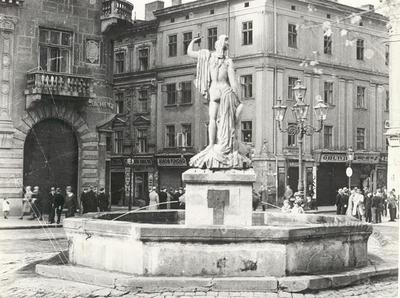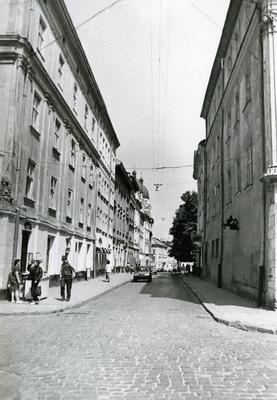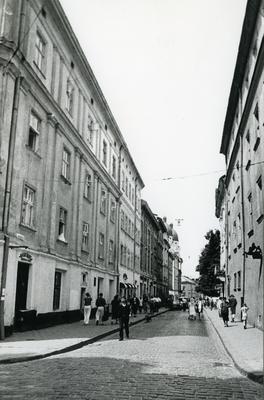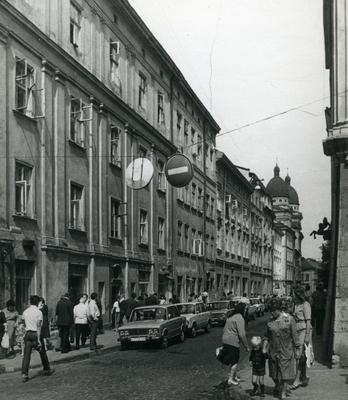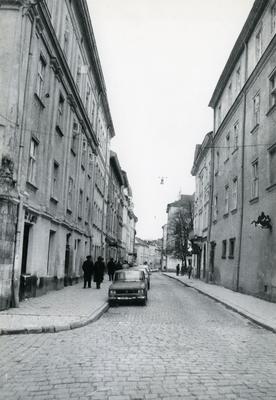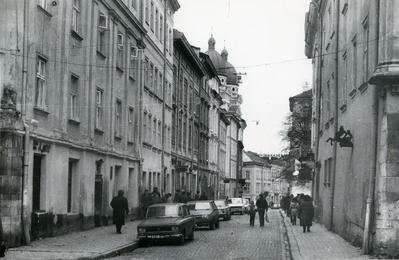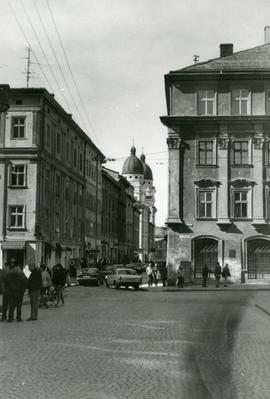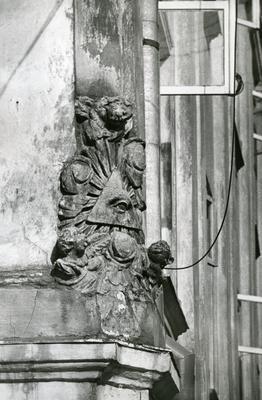Vul. Krakivska, 1 – residential building ID: 2381
The Baroque townhouse with the “all-seeing eye” was built on Gothic cellars of two previous houses at the corner of Krakivska and Shevska streets in the 18th century. It has preserved its old planning structure and unique elements of white stone Baroque carving. According to the resolution of the Council of Ministers of the Ukrainian SSR number 970 dated 23 August 1963, the house was entered in the Register of architecture and urban planning monuments of national significance under protection number 354.
Story
14th c. – a Gothic townhouse
is built on the corner parcel.
Mid-16th
c. – the
house is reconstructed essentially by Andreas Abrek.
1764 – the house is in a
ruined condition.
1769 – a new house is
built at the expense of Antoni Kamiński, a watchmaker;
the “Tarnavskykh” and “Valishevskykh” house on Krakivska street 3 is merged
with it.
1872-1873 – a reconstruction is
performed: a fourth floor is added and a low tin roof is made with an attic
lighted by a row of small windows under the crowning cornice (architect Michał Fechter).
1913 – a portal entrance
is arranged instead of a window from Trybunalska (now Shevska) street
(architect Henryk Salver).
1924 – a portal entrance
is made from Krakivska street (on the extreme axis); the entrance from Shevska
street is bricked up (architect Leopold Reiss).
1939 – a restoration of
the portals (architect A. Bilbel); shop windows are made on the ground floor
from Krakivska street (architect W. Blein).
Mid-20th
c. – a
reconstruction with a change of the planning structure of the building above
ground level: the staircases in both parts of the house are dismantled, and
instead a common one is arranged in the courtyard. There is a custom tailoring
atelier on the ground floor.
1986 – a restoration of
the ground floor is performed (architect Y. Kushnir of the Zakhidproektrestavratsiya Institute).
2004-2005 – a reconstruction of
the roof and repairs of the façades are performed (architect D. Kryvosheyeva,
2001).
2008 – the sculptural composition
of the “All-seeing eye” is restored (restorer Janusz Smaza from Warsaw). The
ground floor premises are adapted for the “Sweets” shop and a tailoring
atelier.
2012 – the ground floor
premises are adapted for the “Diadema” café.
This corner house stands on one of the oldest streets of the town built according to the Magdeburg Law principles. The street begins from the north-western corner of the Rynok (Market) square. The district, where the house is situated, is for the first time mentioned in the oldest of the preserved town record books of Lviv (1382). The street, which began from the north-western corner of the Rynok square and went through the Tartharorum platea (Tatar district), led to the Tatar gate. From 1441 both the street and the gate were called Krakivska (Cracowian).
The housing of the parcel changed with the course of time: the house was renewed and reconstructed substantially; its cellars, though, remained intact from the time of Lviv’s Gothic architecture. In the mid-16th century the house was bought by Andreas Abrek, a Lviv patrician of German origin, doctor of medicine and councillor; it was from him that the house got its name. Abrek reconstructed the old house essentially after it was burnt in the 1556 fire. After his death the house was owned by his widow, Mrs Abrekova. On the walls and shutters of the façade facing Shevska street, Lviv residents used to write various epigrams and to draw caricatures directed against certain citizens and the Magistrate. The first victim of these tricks was Mrs Abrekova herself. In 1601 the Magistrate forbade to do this and even posted a guard near the house. It was in this resolution that the house was called “Abrekivska”. In 1613 the house became a home for military rebels who were not paid after they came back from a campaign against Muscovy.
From the middle of the 17th century till 1767 the house was owned by the family of Bobrocki. In 1764 it was stated by a commission that the house was so ruined that its remains should be dismantled and a new house should be built there. In 1767 the ruin was bought by Antoni Kamiński, a Lviv watchmaker, one of the founders of the watchmakers’ guild in Lviv. In 1769 Kamiński built a new house on the old cellars and merged it with the old house no. 3 known as “Tarnavskykh” (“Tarnawskich”) and “Valishevskykh” (“Waliszewskich”). Various artisans (saddlers, armourers, tailors) lived and worked in the house no. 3 from the 16th century.
In 1872-1873 a reconstruction was carried out: a fourth floor was added and a tin roof was made with attic windows on the façade (architect Michał Fechter). In 1913 a portal entrance was arranged instead of a window facing Trybunalska (now Shevska) street under a project designed by Henryk Salver.
As of 1913, various officials and commersants lived in the house: Jakub Binder, Józef Sokler, Jan Dziuba, Betti Dimand, Izrael Bardach, Szymon Manner. There were two shops on the ground floor, a Chune Scheer’s women’s small wares shop and a seasonings shop owned by Antoni Olejarnik. A men’s clothes shop, which belonged to M. Passel, occupied a part of the house no. 3. There was a bookshop and a hats shop in the interwar period there.
In 1924 a portal entrance was arranged from Krakivska street (on the extreme axis) under a project by Leopold Reiss; the entrance from Shevska street was bricked up. In 1939 a project of the portals restoration was designed by architect A. Bilbel; architect Władysław Bleim designed the ground floor shop windows from Krakivska street.
During a reconstruction in the postwar period the planning structure of the building above ground level was partially changed; the staircases in both parts of the house were dismantled, and instead a common one was arranged in the courtyard. There was a custom tailoring atelier on the ground floor at that time.
A draft design of the ground floor restoration was designed by architect Y. Kushnir of the Zakhidproektrestavratsiya Institute in 1986; the Lviv custom tailoring and clothes repair factory acted as the customer. In 2004-2005 a reconstruction of the roof was performed, as well as repairs of the façades (architect D. Kryvosheyeva, 2001). In 2008 the sculptural composition of the “All-seeing eye” was restored (restorer Janusz Smaza from Warsaw). There was the “Sweets” shop and a tailoring atelier in the ground floor premises of the house no. 1; since 2012 these premises have been occupied by the “Diadema” café.
Architecture
The corner house has two main façades and consists of two medieval townhouses, the “Abrekivska” one (no. 1) and the “Tarnavska” or “Valishevskykh” one (no. 3), which were merged in 1769. It is built of brick on stone foundations with white stone elements used. The house is based on the typical medieval planning and spatial structures: the two-part and three-tract one (no. 1) and the two-part and two-tract one (no. 3). The house has four floors; the ground floor and the fourth floor, which was added later, are emphasized horizontally. The house’s façades are designed in the Baroque style; they are divided by paired pilasters and punctuated by rhythms of rectangular windows in shaped white stone framings. The fourth floor’s decoration reproduces the appearance of the townhouse of the late 18th century: it is divided by fluted pilasters with Ionic capitals. The house’s corner is cut and emphasized by pilasters and a sculptural composition of the “All-seeing eye” over the bar which emphasizes the ground floor. The ground floor’s original architecture has been lost partially. White stone Baroque portals of both gates with a forged grating in the lights and a metal door (first half of the 19th c.) have been preserved. The interior space layout has been changed.
The Gothic cellars are built of limestone and brick with lime and sand mortar; they are bridged with barrel vaults. The entrance to the cellars from the courtyard is closed by a horizontal metal door. Some fragments of white stone portals and a carved portal of the entrance to the cellars have survived. A trace of the stairs leading down from the ground floor has been preserved in the south-western chamber, as well as a white stone portal of the lobby of the entrance, leading to this chamber, on the ground floor (exposed in 2012). The cellars’ southern wall is built of hewn white stone; it has been preserved since the first stage of the townhouse construction. Loading openings with segmental stone crosspieces, which are almost completely closed on the outside (from Shevska street), have survived too. The western wall, on the whole, is built of stone, with a small inclusion of large-size brick. The walls, which separate the cellar’s chambers, are built of stone in their lower part and of brick in their upper part. The entrance opening between the chambers has a segmental brick crosspiece; it is marked out by brickwork with lime and sand mortar and was arranged in the 18th century.
The townhouse on Krakivska street 1-3 is a bright pattern of Lviv’s Baroque architecture of the 18th century; two medieval planning structures and unique elements of white stone Baroque carving have been preserved in it. Also, Gothic cellars from the time of the original masonry housing on the plot in the 14th-15th centuries have survived in the townhouse.People
Andreas (Andrzej) Abrek – a Lviv patrician of German origin, doctor of medicine and councillor, who owned the house from the mid-16th c.Mrs Abrekova – Andreas Abrek’s wife.
Izrael Bardach – an official who lived in the house in 1913.
A. Bilbel – an architect who drew up a project of the house’s portals restoration in 1939.
Jakub Binder – an official who lived in the house in 1913.
Władysław Bleim – an architect who designed the house’s shop windows in 1939.
Bobrocki – a Lviv citizens’ family which owned the house from the mid-17th c. till 1767.
Waliszewski – a Lviv citizens’ family which owned the house no. 3 on Krakivska street.
Jan Dziuba – an official who lived in the house in 1913.
Betti Dimand – an official who lived in the house in 1913.
Antoni Kamiński – a Lviv watchmaker, one of the founders of the watchmakers’ guild in Lviv, who built a new house on the plot in 1769.
Danuta Kryvosheyeva – an architect who drew up a project of the house’s roof and façades restoration (2004-2005).
Yarema Kushnir – an architect who drew up a draft design of the house’s ground floor restoration (1986).
Szymon Manner – an official who lived in the house in 1913.
Antoni Olejarnik – the owner of the seasonings shop.
M. Passel – the owner of the men’s clothes shop which occupied a part of the house no. 3.
Leopold Reiss – an architect who drew up a project of a portal entrance from Krakivska street in 1924.
Janusz Smaza – a restorer from Warsaw who restored the sculptural composition of the “All-seeing eye” in 2008.
Tarnawski – a Lviv citizens’ family which owned the house no. 3 on Krakivska street.
Michał Fechter – an architect who drew up a project of the house restoration in 1873.
Józef Sokler – an official who lived in the house in 1913.
Chune Scheer – the owner of the women’s small wares shop.
Henryk Salver – an architect who drew up a project of arranging a portal entrance instead of a window facing Trybunalska (now Shevska) street.
Sources
- Державний архів Львівської області (ДАЛО) 2/2/5568.
- Центральний державний історичний архів у Львові (ЦДІАЛ) 186/8/829.
- Księga adresowa Król. stol. miasta Lwowa (Lwów, 1913).
- Вуйцик Володимир, Державний історико-архітектурний заповідник (Львів: Каменяр, 1991).
- Зубрицький Денис, Хроніка міста Львова (Львів: Центр Європи, 2006).
- Капраль Мирон, Національні громади Львова XVI–XVIII ст. (Львів: Піраміда, 2003).
- Мельник Б., Довідник перейменувань вулиць і площ Львова (Львів: Вид-во "Світ", 2001).
- Мельник Б., Шестакова Н., "Кам'яниці Львівського середмістя", Наукові записки. Львівський історичний музей, 2008, Випуск XII, 133-158.
- Могитич Роман, "Архітектура і містобудування доби середньовіччя (XIII – поч. XIV ст.)", Архітектура Львова: Час і стилі. XIII–XXI ст. (Львів: Центр Європи, 2008).
- Могитич Роман, "Ліктьовий податок", Вісник ін-ту Укрзахідпроектреставрація, 2009, Ч. 19.
- Памятники градостроительства и архитектуры Украинской ССР, Т. 3 (Киев: Будивэльнык, 1985), 24.
- Путівник по Львову (Львів: Центр Європи, 1999).







